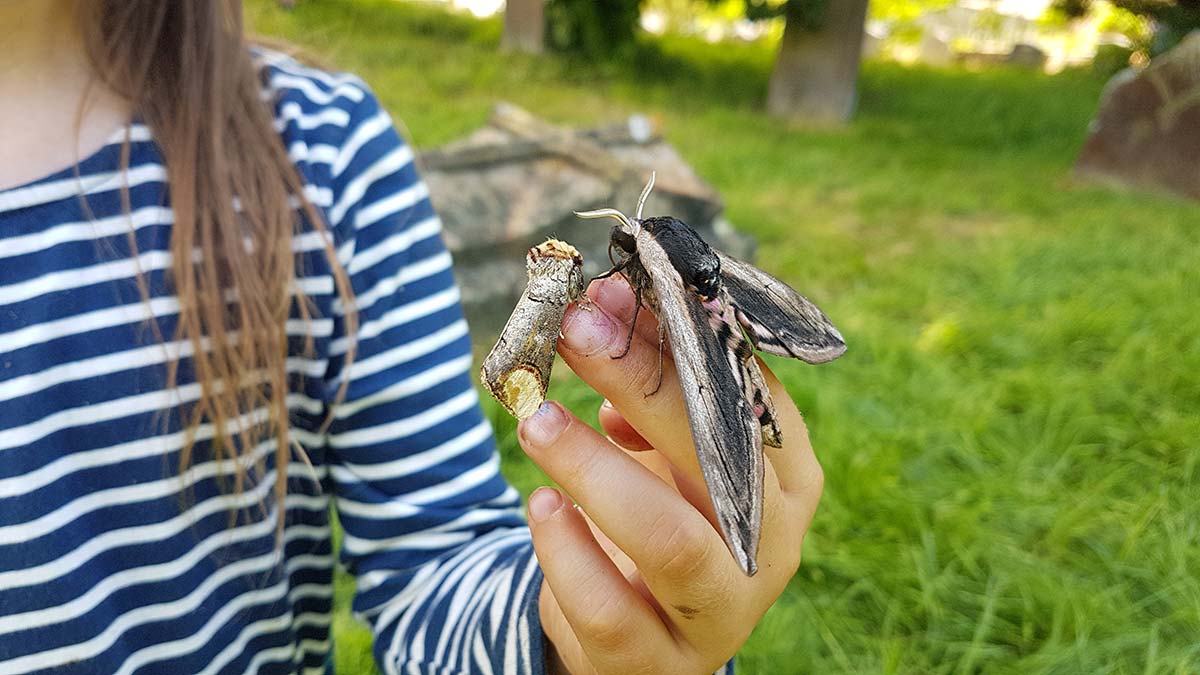(IMAGE: Buff-tip and a Privet Hawk-moth as photographed by Emily Best)
Churchyards and church spaces are some of the UK’s most unpolluted nature sites. From 4-12 June 2022, Churches Count on Nature (CCON) brought communities together to discover the wildlife in their local churchyard. Over 250 churches across England and Wales took part, counting many species, including rare and endangered ones, in their churchyards, spaces and burial grounds across England and Wales.
Emily Best from St Michael’s Church Eco Team shared about their experience of welcoming hundreds of school children to their church grounds:
During Churches Count on Nature week, the Eco Team ran biodiversity monitoring workshops for their local C of E school and village pre-school. These are located next door to St Michael’s church in the centre of Aldbourne, Wiltshire, and approximately 230 children participated.
Each session began with a welcome from one of the clergy, who shared God’s creative nature and how He has loaned the natural world to us to enjoy and protect. We sang, “He’s got the whole world in his hands”, and thanked God in prayer for his beautiful world. Each group spent 1.5-2.5 hours with us being “wildlife detectives” using their senses and monitoring equipment to survey the wildlife in the churchyard.
We peered inside six hedgehog footprint tunnels, and four small mammal footprint tunnels, baited with cat food and peanuts set out the night before each session to detect evidence of nocturnal visitors. Over the week, we found hedgehog footprints in all corners of the churchyard, numerous small mammal tracks (vole, mouse and rat), and cats! We set ten Longworth mammal traps each night (kindly lent by Wiltshire Mammal Society) and found wood mice and bank voles.
Aldbourne is fortunate to be home to numerous slow worms which appear to love the churchyard. We checked under ten slates which rest in the long grass at the top of the churchyard. On some days, we found up to eight slow worms resting and warming themselves under them, not to mention numerous invertebrates such as several species of ants, snails, woodlice, slugs, spiders etc.
One of the highlights of the school visits was exploring what had been attracted to our moth trap during the previous nights. We found 51 species of moth during the week, ranging from micros including Green Oak Tortrix and White Plume moths to the big Elephant and Privet hawk-moths.
To finish the sessions, each class hunted for stones, each painted beautifully with pictures of flowers and a word from Psalm 24.1. After putting them in order, they spelt out the verse “The Earth is the Lords, and everything in it”, reminding the children of the message shared at the workshop’s beginning.
It was wonderful to see the children’s (and teachers’) excitement when checking the traps and tunnels and to share their amazement at the species found. Some said they had never properly been into the churchyard before.
Thanks to Emily for sharing about how her church took part in CCON.
If you’re keen to take part next time, sign up to receive our monthly eNews and be the first to hear about Churches Count on Nature in 2023.
Alongside CCON, the Church of England Environment Programme ran a special series of accompanying webinars on different aspects of land and nature. You can find the recordings from the 2021 and 2022 seasons here.

